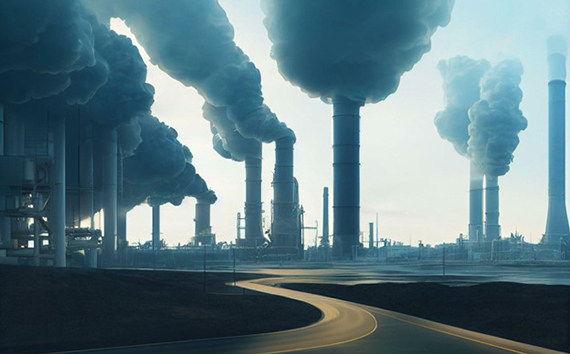While some climate change is normal, human actions have dramatically accelerated it. And this has led to increased severe weather events, rising sea levels, and global warming. With the Paris Agreement in place and many countries onboard with reducing their emissions, we have a clear pathway to slowing and even reversing climate change. Unfortunately, the world is still off-track for meeting the goals of the Paris Agreement, so we all need to do more.
To try to help get the U.S. on track and potentially spur the same action worldwide, the government has announced major funding to kick-start growth in the U.S. carbon removal industry. This technology remains relatively new and still needs more research to meet the levels needed to make a significant impact, but the hope is these funds will help get that in motion.
Learn all the details about the billions of dollars the U.S. government is injecting into the carbon-removal industry and how it can help the environment below.
How Much Did the U.S. Government Commit to Funding Carbon Removal?
The U.S. Department of Energy (DOE) recently announced it would commit $3.7 billion to finance projects to remove carbon dioxide (CO2) from the atmosphere. This is in an attempt to kickstart our commitment to emit net-zero greenhouse gas emissions (GHG emissions) by 2050 and slow climate change through the commercialization of carbon sequestration and storage.
In a second round of funding the DOE announced another $2.52 billion for two carbon capture initiatives. Of these funds, $820 million will go to 10 projects targeting the de-risking of carbon-capture technology. This will help organizations test new technology in the power and industrial sectors.
The remaining $1.7 billion will support six carbon-capture demonstration projects showing how the technology works and can be replicated and installed at power plants and in the cement, pulp and paper, iron, and steel industries.
This influx of cash will help fund the government’s previously announced plans to finance four direct air capture hubs (DAC hubs) that remove CO2 from the air and store it underground.
In addition to this funding and the four CO2 removal facilities, the DOE also announced programs that will bolster research on carbon removal technology and provide grants to state and local governments and utilities for carbon use. These programs are funded through the bipartisan infrastructure law.
What Else Is the Government Offering to Boost DAC Commercialization?
On top of offering grants to build these carbon-absorbing facilities, the government is also offering a tax credit for carbon sequestration. All carbon absorption is eligible for a tax credit of $85 per metric ton when it’s permanently stored or $60 when it’s used for enhanced oil recovery (EOR) or industry.
To be eligible for this tax credit, power plants must absorb at least 18,750 metric tons of CO2 annually, and other industries must absorb at least 12,500 tons.
On top of this, organizations that build carbon-absorption facilities will receive an even larger tax credit of $180 per metric ton of carbon removed and permanently stored and $130 per metric ton of carbon used for enhanced oil recovery or industry. To qualify for the tax credit, these facilities must absorb at least 1,000 tons of carbon annually.
So, if a facility can absorb the 1 million metric tons of CO2, as the U.S. government anticipates, it can get a hefty $130 million to $180 million tax credit.
For all the tax credits mentioned above, organizations have until 2033 to begin constructing their carbon absorption technology to qualify — a seven-year extension on the previous tax credits.

How Much CO2 Can These Facilities Remove?

There has been a lot of development in CO2 removal technology. Currently, 18 direct air capture plants operate worldwide, each capturing 0.01 megatons (Mt) — a megaton is 1 million tons — of CO2 annually. The first of the facilities funded through this initiative is already in advanced development, and it’s projected to remove 1 Mt of CO2 annually. That’s equal to removing over 200,000 fossil-fuel-burning vehicles off the road.
By 2030, experts anticipate the technology will be available to scale these facilities up to 60 Mt of CO2 removal annually.
What Will Happen with the Captured CO2?
You’re likely wondering what happens to all the CO2 these facilities capture. They can’t store it forever, right? The storage facilities are designed for permanent geological storage — storage deep within geological formations. One permanent solution in the works is a plant that pumps the CO2 underground so it can combine with basalt and turn into stone.
However, other options exist too, such as using the captured carbon in food processing or creating sustainable synthetic fuel. In these instances, the organizations operating these carbon capture facilities can sell the CO2 to other companies to help recoup some of their costs.
Some examples of how this CO2 can be used include:
- Enhanced oil recovery: When an oil well runs dry, a small amount of oil is often left in the bottom. Oil companies then rely on pressure — often from pressurized CO2 — to get the leftover oil out of the ground.
- Synthetic fuels: When combined with hydrogen, CO2 becomes a synthetic fuel that various industries can burn. Then, these industries can recapture the CO2 emissions to prevent releasing it into the atmosphere again. They then restart the process, making it almost like a renewable energy source.
- Crop growth: Plants and trees use CO2 for photosynthesis, and selling compressed CO2 to greenhouses can help spur crop yield. One company sells 900 metric tons (tonnes) of CO2 to a pickle company to aid in cucumber growth.
How Much Does It Cost to Capture and Store Carbon?
Capturing carbon and storing it is far from a free act. These companies will incur significant expenses in performing this important climate action. Depending on the facility, capturing a metric ton of CO2 costs between $100 and $1,000. However, experts in the field say these estimates are “unduly pessimistic” and believe this cost can get as low as $94 per tonne as technology advances.
As the technology continues to develop and lowers in cost, this price could fall even further, making it a reality for more industries to install them at their factories and power plants. And the U.S. government is helping push this along with all the funds it’s pouring into the environment-saving technology.
Who Bid for a $500 Million U.S. Climate Grant for Direct Air Carbon Capture?

Two corporations have partnered with a nonprofit organization to bid for a $500 million grant from the U.S. to build a commercial direct air capture facility. The two corporations are Switzerland’s Climeworks and California’s Heirloom, and the nonprofit joining the project is Battelle.
These three organizations are no strangers to climate technology. Battelle has worked with carbon capture tech in the past and even managed some of the government’s centers and labs. Heirloom operates a small-scale carbon-capture demonstration project in California, and Climeworks operates the largest DAC facility in the world, which removes 4,000 metric tons of CO2 annually.
Other companies are closing in on applying for federal funding for their DAC projects. Occidental Petroleum plans to build a $1.1 billion DAC facility in Texas, with a projected start in 2024. Another company in California plans to build a facility in Wyoming that could remove 5 million metric tons of CO2 annually by 2030.
Other organizations are likely putting together proposals to deliver to the U.S. Department of Energy for review, and we’ll learn more about those as they are approved and funded.
Who Is Funding Carbon Capture?
While the U.S. Department of Energy is heading up these initiatives, the funding will come from a different source. Both the $3.7 billion to fund the four decarbonization facilities and the $2.52 billion to fund de-risking of carbon-capture technology and developing carbon-capture demonstrations will come from President Biden’s $1 trillion bipartisan infrastructure law. This law earmarked funds for refurbishing roads, bridges, and airports as well as reducing carbon emissions.
What Carbon Removal Organizations Are on the Stock Market?
With a healthy influx of cash from the federal government, carbon removal companies on the stock market may be a sound investment for climate-focused investors. Some publicly traded companies to consider include:
- Global Thermostat
- Occidental Petroleum
- Equinor
- Aker Carbon Capture
- Delta CleanTech
These five companies are all traded publicly on the stock market, but a leader in this space, Climeworks, is not. You may still want to watch Climeworks, as it may choose to go public and offer shares on the open market.
DAC Facilities Will Help, But You Can Still Play a Role

The DOE’s major funding to kick-start U.S. carbon-removal industry will likely be a big boost to our goal of reaching net-zero emissions as a nation. The potential to remove millions of tons of CO2 is just one part of the equation. This will also help commercialize the technology, which can drive down the price to build DAC facilities and make them even more efficient, compounding our ability to suck CO2 from the atmosphere and store it or reuse it in various eco-friendly ways.

While these DAC facilities will help, you can still play a huge role by reducing your carbon footprint by purchasing carbon credits. These credits can offset a wide range of things, including commercial flights, vacations, and more.
Check out Terrrapass’ wide range of carbon credits, and find one that can help you offset your CO2 emissions and help slow the impacts of climate change and global warming.
Brought to you by terrapass.com
Featured image:
- SEO Powered Content & PR Distribution. Get Amplified Today.
- PlatoData.Network Vertical Generative Ai. Empower Yourself. Access Here.
- PlatoAiStream. Web3 Intelligence. Knowledge Amplified. Access Here.
- PlatoESG. Automotive / EVs, Carbon, CleanTech, Energy, Environment, Solar, Waste Management. Access Here.
- BlockOffsets. Modernizing Environmental Offset Ownership. Access Here.
- Source: https://terrapass.com/blog/doe-to-deliver-major-funding-to-kick-start-u-s-carbon-removal-industry/



